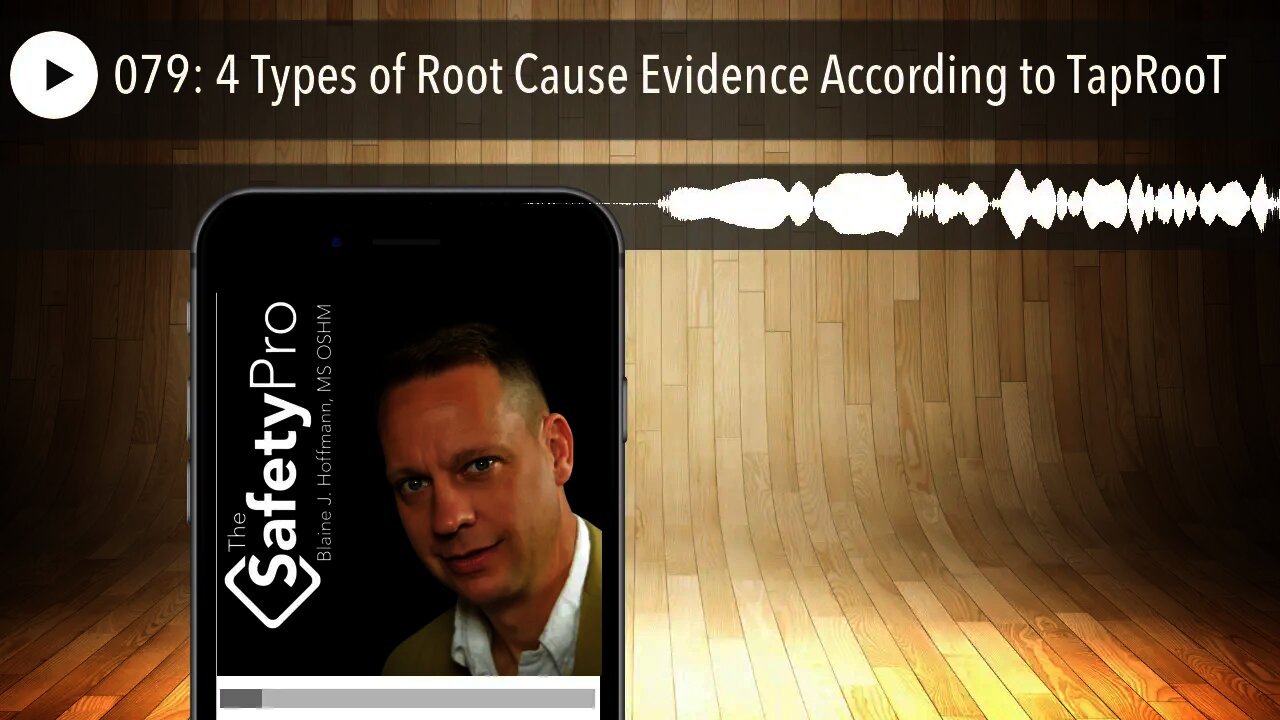Premium Only Content

079: 4 Types of Root Cause Evidence According to TapRooT
Subscribe here:
http://www.thesafetypropodcast.com
Powered by iReportSource
When an incident occurs it is the investigator’s main function to gather all relevant evidence in order to discover root causes and ultimately prevent a recurrence. The tricky part is that evidence isn’t always what it seems. Witnesses accounts can be spotty, inconsistent, they may tell conflicting stories about the same incident, etc. Physical or even environmental conditions can change before the investigation process begins. Paperwork, such as a work instruction or JSA, may be misplaced or even changed in some way. With all of these variables and more, you want to make sure you collect the right types of evidence during your investigation.
I want to share with you some information from TapRooT® , which is a systematic process and training for finding the real root causes and precursor incidents, for not only major accidents but minor mishaps and even near misses. According to TapRooT® , there are four types (or categories) of evidence to be evaluated. TapRooT® calls these categories 3 Ps and an R. This stands for:
• People evidence
• Paper evidence
• Physical evidence
• Recording evidence
People Evidence
Often, evidence collection starts with people evidence (a witness statement), and that evidence guides the investigator to collect paper, physical and recording evidence.
Examples of people evidence include:
• Interviews
• Fatigue-related information
• Evidence of injuries, including cuts and scrapes, bruises, fractures, or sprains
• Information about medical conditions that may have influenced performance (refer to HR or corporate counsel for guidance on HIPPA)
Where do you begin? First, determine who was involved. This includes those who planned the work, supervised the work and performed the work. Other considerations include a worker’s capability, capacity, training, and qualification to perform his or her role.
Inquire into the background of those involved. Determine if they have been involved in any previous incidents or if they have any related performance or conduct issues. Find out if those involved had any work restrictions such as an impairment, physical capability, or lapsed accreditation.
Understand how the employees worked together. What were the dynamics of the team including supervision and team performance? Determine the context (such as environmental conditions, distractions or perspectives).
Paper Evidence
Paper evidence may include all sorts of things including:
• Regulatory paperwork
• Activity-specific paperwork
• Personnel paperwork
• Policy and procedure paperwork
• Equipment manuals
What do you think the biggest mistake is when it comes to collecting paper evidence… given all of the paper that we have in our workplaces? Collecting too much paper not relevant to the investigation!
You don’t need to collect every piece of paper at your facility. How do you know what you don’t need? By looking at the timeline of events that led to the incident. You need all the paper that supports your timeline of events and supports the facts. If you use TapRooT® , you can easily upload digital copies of this paperwork, and highlight relevant pages in your report to management.
Don’t make the mistake of collecting so much paper that what you need for evidence is somewhere at the bottom of the stack.
Physical Evidence
Physical evidence can range from a very large piece of machinery to a very small tool. It includes hardware and solid material related to the incident. You will gather physical evidence in one of two ways. You will collect it or you will record/document evidence that can’t be collected (for example, it is too large to collect, or it is still in use).
Types of physical evidence to collect:
• Broken equipment/parts
• Residue/debris
• Fluid samples
• Paint samples
• Fiber
• Hair, bloodstains, tissue or other DNA
Types of physical evidence to record/document
Evidence is recorded when it is impossible to collect or when it is still in use by the workforce. Following is a list of possible evidence to collect by recordings:
• Burn marks and flame patterns
• Tracks
• Indentations
• Handprints, Footprints, Fingerprints
• Tools
• Equipment
• Products in use
• Equipment status (fixed, portable or temporary?)
• Lights, noise, and temperature
• Confined space
• Obstructions
• Surface hazards
• Housekeeping
• Clarity of signs and labels
• Instructions
Following are additional pieces of information you may want to collect:
• Failure history
• Modification/change of use
• Operator interface
• Maintenance records
• Installing/commissioning
• Storage/transportation
• Procurement
• Design/fabrication
Recording Evidence
Recording evidence, such as photography and video, should be captured as soon as possible after an incident to preserve the scene in images before it is altered in any way. It provides a d
-
 1:03:45
1:03:45
Donald Trump Jr.
19 hours agoHappy Festivus: Airing Our Grievances and Stopping The Swamp w/Sean Davis | TRIGGERED Ep.201
285K298 -
 1:58:10
1:58:10
Robert Gouveia
17 hours agoMatt Gaetz REJECTS Report, Sues Committee; Luigi Fan Club Arrives; Biden Commutes; Festivus Waste
206K141 -
 58:10
58:10
Kimberly Guilfoyle
18 hours agoAmerica is Back & The Future is Bright: A Year in Review | Ep. 183
110K62 -
 3:03:27
3:03:27
vivafrei
23 hours agoEp. 242: Barnes is BACK AGAIN! Trump, Fani, J6, RFK, Chip Roy, USS Liberty AND MORE! Viva & Barnes
202K209 -
 8:09:50
8:09:50
Dr Disrespect
21 hours ago🔴LIVE - DR DISRESPECT - MARVEL RIVALS - GOLD VANGUARD
211K34 -
 1:15:00
1:15:00
Awaken With JP
20 hours agoMerry Christmas NOT Happy Holidays! Special - LIES Ep 71
272K219 -
 1:42:21
1:42:21
The Quartering
22 hours agoTrump To INVADE Mexico, Take Back Panama Canal Too! NYC Human Torch & Matt Gaetz Report Drops!
199K116 -
 2:23:15
2:23:15
Nerdrotic
21 hours ago $15.98 earnedA Very Merry Christmas | FNT Square Up - Nerdrotic Nooner 453
147K13 -
 1:14:05
1:14:05
Tucker Carlson
21 hours ago“I’ll Win With or Without You,” Teamsters Union President Reveals Kamala Harris’s Famous Last Words
253K393 -
 1:58:31
1:58:31
The Dilley Show
21 hours ago $38.23 earnedTrump Conquering Western Hemisphere? w/Author Brenden Dilley 12/23/2024
184K50